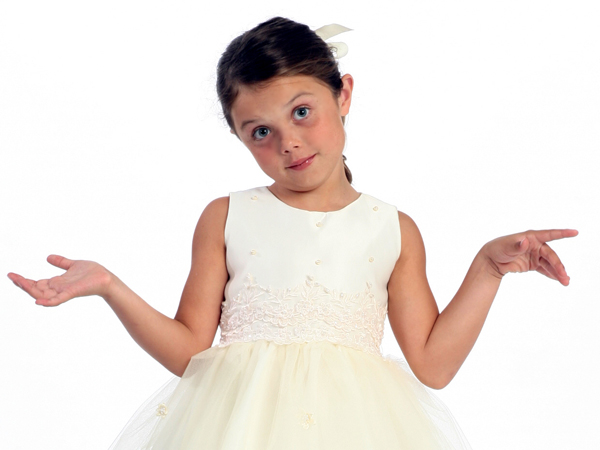Modern flower girls always precede the bride down the aisle. They may carry flower baskets or spread pretty petals. Yet flower girls never fail to steal our hearts. The beautiful bride and the sweet flower girl always steal the show! Flower girls have enchanted wedding guests throughout the centuries.
Ancient Rome
The first young attendants made an appearance at weddings in ancient Rome. During that period, they carried sheaths of wheat and herbs. This bounty was associated with blessings of prosperity and fertility.
Medieval Times
During medieval times, young attendants carried garlic. It was believed that garlic would ward off evil spirits. Varied significance was given to different herbs during this period.
Elizabethan Era
In the Elizabethan era, the path from a bride's home to the church would be covered with rose petals. A flower bearer followed the musicians in the wedding procession. The flower girl would carry a silver bride's cup adorned in ribbons. She would also hold a gilded rosemary branch.
Victorian Era
The flower girl of Victorian times more closely resembles the modern flower girl. Their dresses were of white muslin and featured a colored ribbon sash. Modern flower girl styles continue to use sashes to introduce vibrant color. With our "Create Your Dress," you can even create an unique flower girl dress with a fashionable sash.
Edwardian Era
Flower girl dresses with satin sashes continued to be popular during the Edwardian era. The dresses often followed the style of adult gowns. Pouched over bodices and low slung skirts were popular features.
1920s
Flower girl dresses in the 1920s were influenced by the "flapper" style of the time. Flapper dresses used a "sheath" style. These dresses didn't have waistlines or full skirts. The sheath was a simple, comfortable style which still inspires vintage-style fashions.
1930s
Flower girls during this period were part of the "Stylish 30s." Soft ruffles and ribbon bows adorned dresses during this decade. The designs worn by Shirley Temple, the iconic child actress of the 1930s, give us a glimpse into this period.
1940s
Flower girls and children in general were welcomed at weddings in the 1940s. Celebrations were inclusive affairs rather than being exclusive events. It wasn't even uncommon to have two flower girls participating in a ceremony. The wedding of H.R.H. Princess Elizabeth and Prince Philip in 1947 impacted wedding fashion towards the end of this decade.
1950s
Flower girls looked fantastic in the 1950s! Chiffon, satin, organza, and lace were used to create memorable styles. Flower girl dresses showed soft, flowing, and beautiful fashion during the 1950s.
1960s
A flower theme is synonymous with the 1960s. Flower girl dress fashion was in full and glorious bloom. One 1960s style featured a lace overlay of white daisies topping a lemon lining. Soft puffed sleeves and an empire waist completed the look.
1970s
Flower girls in the 1970s could wear casual prints or more formal fashion. The empire waist style was seen everywhere. A laced-up bolero jacket often provided that final fashionable touch.
1980s
Flower girls often carried dried flowers during the 1980s. The fashion scene, however, was very fresh and alive during this decade. The 1980s was the age of romanticism as well as the time for "power dressing." Fashion followed many directions. Styles were influenced by popular culture and a princess. The television show "Dynasty" and "Princess Diana" drove the style of this decade.
1990s
The 1990s were seen as a time of "dressing down" when more casual fashion was in vogue. The casual trend seemed to inspire people to put extra emphasis on their special occasions. They wanted their formal wear to give them extra special fashion.
We had been in the children's clothing business for two decades by the 1990s. During the early nineties, our company recognized the customer demand for superb formal wear. We shifted our focus from that point onward to the special occasions market.
2000-2009
Since 2000, the demand continues to grow for superior design in flower girl dresses. These fashions must appeal to children and adults. Flower girl dresses must have elegant style and exquisite color. Flower girl dresses should be sweet, fashionable, and fun creations. The role of flower girls and the flower girl dress itself changed throughout history. Their role and their gorgeous dress styles will continue to evolve in the future.One constant truth, however, will continue to fit flower girls. They will always be sweet little princesses who love fun and spread joy. Flower girl fashion will follow with sweet beautiful styles.
Click here for more Flower Girl Tips

 US Dollar
US Dollar
